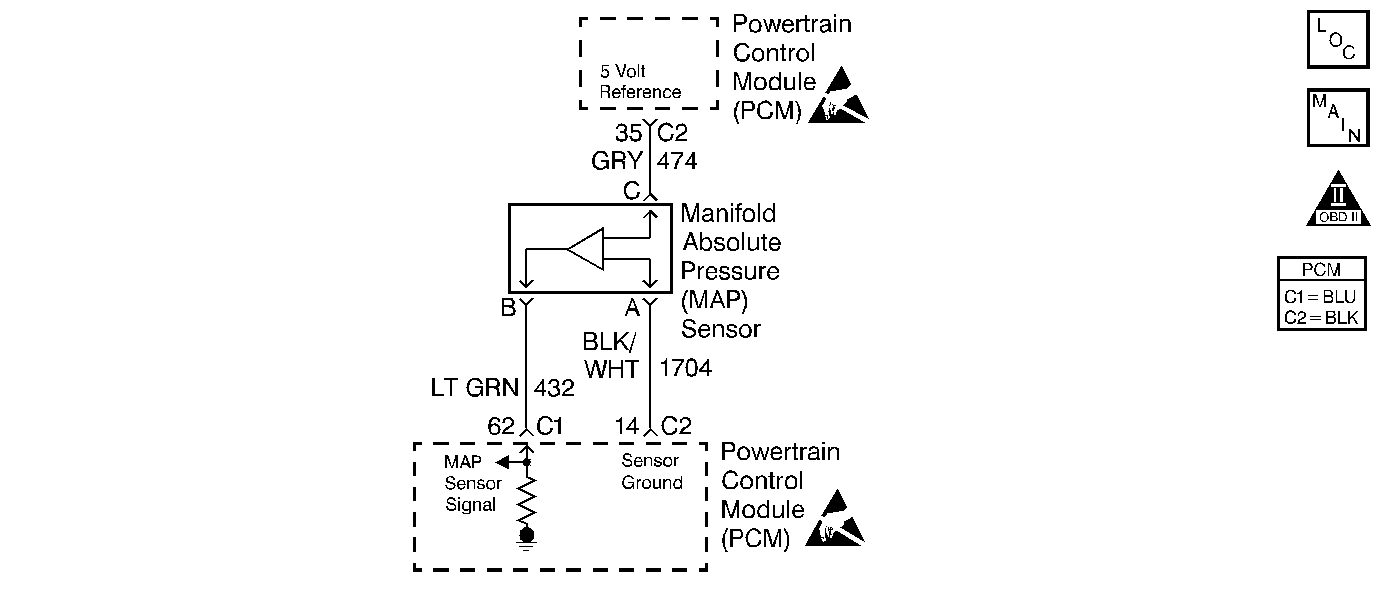
Circuit Description
The powertrain control module (PCM) uses the manifold absolute pressure (MAP) sensor output voltage in order to assist in controlling the fuel delivery and the ignition timing. The PCM supplies a 5 volt reference signal voltage and a ground circuit to the MAP sensor. As the manifold pressure changes, the output voltage of the sensor also changes. By monitoring the sensor output voltage, the PCM knows the manifold pressure. A lower pressure (low voltage) output voltage will read between 1.0 to 1.5 volts at idle. While higher pressure (high voltage) output voltage will read between 4.5 to 4.8 at wide open throttle (WOT). The PCM uses the MAP sensor to record the barometric pressure during an engine start up and at wide open throttle. This allows the PCM to make adjustments for different altitudes.
Conditions for Running the DTC
| • | No active TP DTCs |
| • | The throttle position (TP) sensor is less than 12 percent. |
| • | The vehicle speed sensor (VSS) is less than 2 km/h (1 mph). |
| • | The engine run time is more than 20 to 40 seconds. |
Conditions for Setting the DTC
| • | The MAP sensor is more than 3.80 volts. |
| • | The above conditions are met for at least 1.25 seconds. |
Action Taken When the DTC Sets
| • | The control module illuminates the malfunction indicator lamp (MIL) if a failure is detected during 2 consecutive key cycles. |
| • | The control module sets the DTC and records the operating conditions at the time the diagnostic failed. The failure information is stored in the scan tools Freeze Frame and Failure Records. |
Conditions for Clearing the MIL/DTC
| • | The control module turns OFF the MIL after 3 consecutive drive trips when the test has Run and Passed |
| • | A history DTC will clear if no fault conditions have been detected for 40 warm-up cycles. A warm up cycle occurs when the coolant temperature has risen 22°C (40°F) from the startup coolant temperature and the engine coolant reaches a temperature that is more than 70°C (158°F) during the same ignition cycle. |
| • | Use a scan tool to clear the DTCs. |
Diagnostic Aids
Important:
• After repairs use the scan tool Fuel Trim Reset function to reset
long term fuel trim to 128 (0 percent). • Whenever a misfire is present, repair the cause of the misfire
before using this table. The misfire counters may be used to determine which
cylinders are misfiring.
With the ignition ON and the engine OFF, the manifold pressure is equal to the atmospheric pressure and the signal voltage will be high. The PCM uses this information as an indication of the altitude of the vehicle. A comparison of this reading with a known good vehicle with the same sensor is a good way to verify the accuracy of a suspect sensor. Readings should be the same ± 0.4 volt.
Whenever a DTC P0108 is intermittent, refer to Symptoms for further diagnosis.
Test Description
The numbers below refer to the step numbers on the diagnostic table:
-
This step will determine if the DTC P0108 is the result of a hard malfunction or an intermittent condition.
-
This step simulates the conditions for a DTC P0107. If the PCM recognizes the change, the PCM, 5.0 volt reference and the MAP sensor signal circuits are OK.
-
The replacement PCM must be programmed and the Crankshaft Position System Variation Learn procedure must be performed.
Step | Action | Values | Yes | No | ||||
|---|---|---|---|---|---|---|---|---|
1 | Did you perform the Powertrain On-Board Diagnostic (OBD) System Check? | -- | ||||||
Does the MAP sensor voltage read more than or equal to the specified value? | 4.0 V | Go to Diagnostic Aids | ||||||
Does the MAP voltage read less than or equal to the specified value ? | 1.0 V | |||||||
4 |
Does the test lamp illuminate? | -- | ||||||
5 |
Did you find and correct the condition? | -- | ||||||
6 |
Does the DMM read near the specified value? | 5.0 V | ||||||
7 |
Did you find a problem? | -- | ||||||
8 |
Important: The PCM uses a single internal 5.0 volt power supply to supply power to all the engine control components. If one component shorts it's 5.0 volt reference circuit to ground or battery voltage, the other 5.0 volt reference circuits will also have a low or high voltage.
Did you find and correct the condition? | -- | ||||||
9 | Repair the vacuum source as necessary. Did you complete the repair? | -- | -- | |||||
10 |
Did you find and correct the condition? | -- | ||||||
11 |
Did you find and correct the condition? | -- | ||||||
12 | Replace the MAP sensor. Refer to Manifold Absolute Pressure Sensor Replacement . Did you complete the replacement? | -- | -- | |||||
|
Important:: The replacement PCM must be programmed. Replace the PCM. Refer to Powertrain Control Module Replacement/Programming . Did you complete the replacement? | -- | -- | ||||||
14 |
Does the DTC reset? | -- | System OK |
